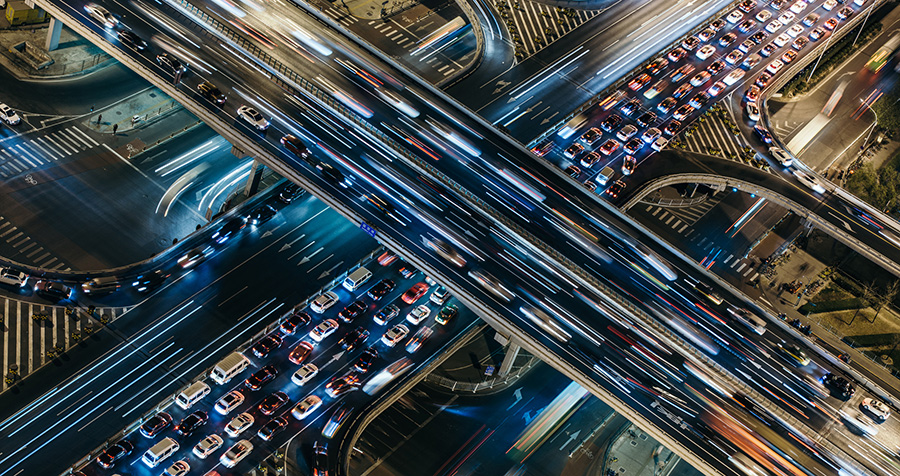How well cities move their citizens is a significant factor in determining people’s wellbeing and the dynamism of their urban environment. To overcome today’s transportation challenges, smart cities must leverage behavioural information obtained by the Internet of Things, big data analytics, and the viewpoints and ideas of the private sector and general public.
One of the biggest changes occurring in how societies move is “Mobility as a Service” (MaaS)—the integration of various forms of transport services into a single, accessible, on-demand service. MaaS has the potential to hugely benefit society, and Hitachi aims to make this concept a global reality through collaborative creation.
Urbanization has had an enormous impact on the world over the past century. Natural increases in population and rural-to-urban economic migration drove the exponential growth of cities globally. Transportation played a critical role in this trend—bringing in the people, goods and materials that built cities, and then continuously moving them from one place to another. But, as cities grew and demand for mobility systems increased, both public and private modes of transport soon faced an array of challenges.
One of the most visible issues facing urban transportation is congestion. Sitting in traffic for hours not only contributes to public unhappiness, it is also expensive. A 2017 report by The Economist revealed that the total cost of congestion in America, Britain and Germany was calculated at US$461 billion, or US$975 per person . Thus, there is a globally rising need to depart from overdependence on private automobiles.

Another challenge facing cities is delivering mobility to all demographics and sections of society. By 2050, 2.1 billion people worldwide, around 21% of the global population, will be aged 60 years and over. As the population ages, the percentage of elderly drivers increases. While in many countries there are no special traffic rules for older drivers, their reduced physical abilities require them to be especially careful. Higher vulnerability of older drivers is due to the reduced physical abilities of older drivers (i.e. diminished eyesight and hearing, slower reaction time) and less day-to-day experience on the roads. To ensure the safety, well-being, and quality of life of the elderly population, cities must be aware of the potential risks and prepare for future mobility. For example, in Hong Kong, the government subsidises older people’s transport, so they pay just HK$2 (US$0.2) for most trips on public transit. This encourages the elderly to travel safely and engage more actively with their family, friends and the wider community.
As more and more people move to the cities—according to the United Nations, two-thirds of the world’s population will be living in urban environments by 2050 —rural communities’ risk being undersupplied with mobility services and transportation infrastructure. Viable mobility is vital for rural communities’ health, education and economic prospects. In rural Japan, where this issue is particularly prevalent, some communities are implementing possible solutions.
Delivering comprehensive urban mobility is expensive. Many experience labour shortages, due to diminishing workforces caused by aging populations. Left unaddressed, the strains placed on urban mobility systems will continue to exacerbate social, economic and environmental issues.

The past decade has seen the introduction of new technologies that are revolutionizing the service economy. Ubiquitous internet connectivity, the proliferation of sensors and autonomous technology, the sharing economy and widespread electrification are trends that are disrupting conventional modes of transport. Autonomous electric vehicles now challenge gasoline-fuelled motorcars, and in many cities around the world, conventional taxi services have been replaced by ride-hailing apps.
The way people perceive mobility is also rapidly changing. Owning an expensive, high-performance automobile is no longer necessarily viewed as a status symbol. The value people place on mobility is shifting towards wallet-friendliness, environmental consciousness, easing congestion, healthy living, and comfortability. In this diversified environment, sharing, accepting and collaborating is the key to solving issues and working towards a more fulfilling, happier society.
This wave of transformation has helped give rise to “Mobility-as-a-Service” (MaaS). A concept that emerged in the past years, MaaS integrates end-to-end trip planning, booking, electronic ticketing and payment services across all modes of transportation within cities and in real time. Rather than having to locate and pay for each mode of transport individually, MaaS platforms will enable users to plan and book door-to-door trips using a single application.
Transportation should not just be convenient, it ought to be enjoyable and meet the needs and lifestyles of users. Transport must be inclusive, cater to individual preferences, be on-demand, fast, and lead to healthier lifestyles. It must also meet the growing need for cleaner modes of transport, eradicate accidents, and be cost-effective for users and service providers.
To realize enjoyable and sustainable mobility, Hitachi is currently focusing on three aspects of MaaS.
People have different lifestyles and different motivations for travelling. This means the ideal mobility service adapts to an individual’s needs at different moments and times of the day. A flexible platform is essential for transportation service providers to accommodate rapidly changing demands and find the best balance between supply and demand with limited resources.
For MaaS to work effectively, each and every stakeholder must buy into it. Transportation service providers need to adopt a collaborative mindset and embrace the service as one that benefits all industry players. For example, it is difficult for MaaS to be rolled out effectively if individual service provider does not prioritize the society’s growth and the collective good. MaaS requires a stable ecosystem that balances out each stakeholder’s benefit, transparent governance and a robust regulatory framework.
MaaS is accelerating the shift from owning the means of mobility to utilizing public transport. The more users travel with MaaS, the greater the possibility of developing a sustainable, environmentally friendly mobility ecosystem. Morever, MaaS offers each user with a motive to get out and travel, as a result vitalizing the community and its economic activities. To accelerate widespread adoption, local business owners, the public sector and solution providers like Hitachi will play a key role in encouraging people to understand and accept the benefits of MaaS and foster a shared sense of community.

Hitachi’s goal is to create an integrated ecosystem, where citizens travel actively, seamlessly and harmoniously from one place to another, using multiple modes of transport as desired. To help achieve this, Hitachi aims to orchestrate mobility for a more sustainable society.
Within this model, Hitachi is capable of providing citizens with recommendations about travel routes and departure timings, public amenities and places of interest, and provides real time information on events taking place across cities. This approach will motivate people to travel, consume various services, as well as lead to safer, healthier and more exciting daily lives.
For mobility service providers and local business owners, Hitachi will exploit real-time data on traffic activity, forecast consumer and business demand for goods and services, and optimized operation schedules. It is also Hitachi’s role to accelerate collaboration and information sharing between all actors.

The technologies that underpin a seamless integrated mobility system are important, but they must also include human input and insight. Overcoming pressing mobility issues such as congestion, pollution and safety—as well as building robust, cost-effective infrastructure—will continue to need the views and expertise of all stakeholders, including the private and public sectors, academia and NGOs. Most importantly, these efforts must consider the needs and perspectives of the end-users, be they public transport commuters or regular road users, to ensure mobility solutions are fit for purpose.
Relationships between industry players are crucial to solving complex city issues, and for building consensus with governments, Hitachi asserts. What is more important, however, is for each participant—irrespective of the sector within which they work—to foster a mind of mutual assistance and contribute to the greater good.
The Tokyo suburb of Toyosu is one of the most congested in Tokyo. With public transport under strain due to population growth and increasing numbers of visitors to the suburb, citizens and commuters need a mobility service that is comfortable, timely and less congested. The number of people living in and commuting to Toyosu is expected to grow four times by 2030.
One of the most built-up suburbs in Japan, Toyosu has been designated one of 15 smart city projects promoted by Japan’s Ministry of Land, Infrastructure, Transport and Tourism. The goal in Toyosu is to overcome an array of urban issues through smart technologies.

A member of the Toyosu Smart City Consortium, Hitachi is working with a team of public and private stakeholders to solve Toyosu’s mobility challenges. The company is focused on two areas: firstly, the development of a new data integration platform for mobility, which will show supply and demand in real time; and secondly, the launch of a last-mile mobility service.
The project leverages data and expertise provided by government, academia, and private companies. Using real-time traffic data, passengers are presented with a wide range of transportation options from which to choose from, while shuttle providers leverage live information on passenger demand to provide a more timely and efficient service.
The project exemplifies how mutual assistance is benefitting various city actors. It also showcases Hitachi’s abilities as a partner for future MaaS projects. With smart cities proliferating across Japan, MaaS projects like that of Toyosu will continue to emerge nationwide.